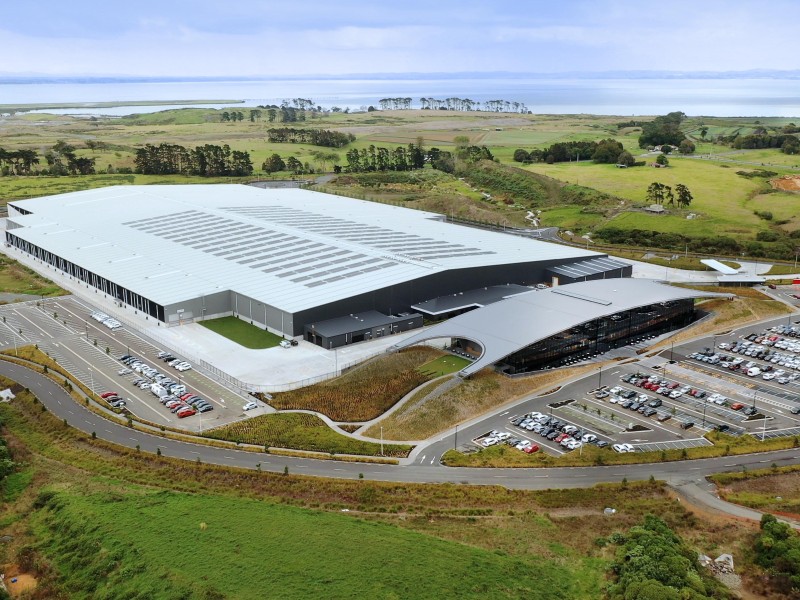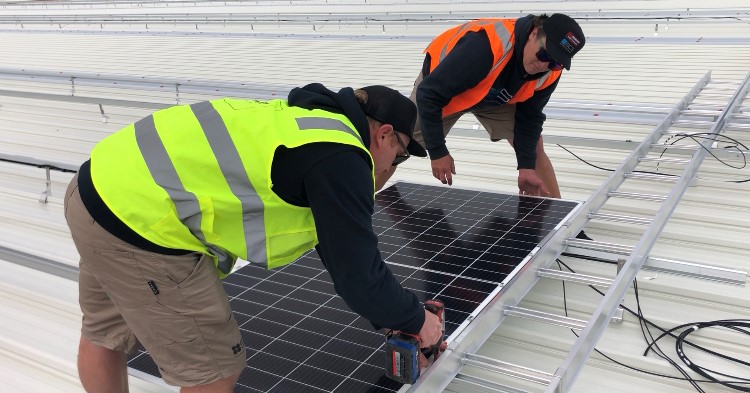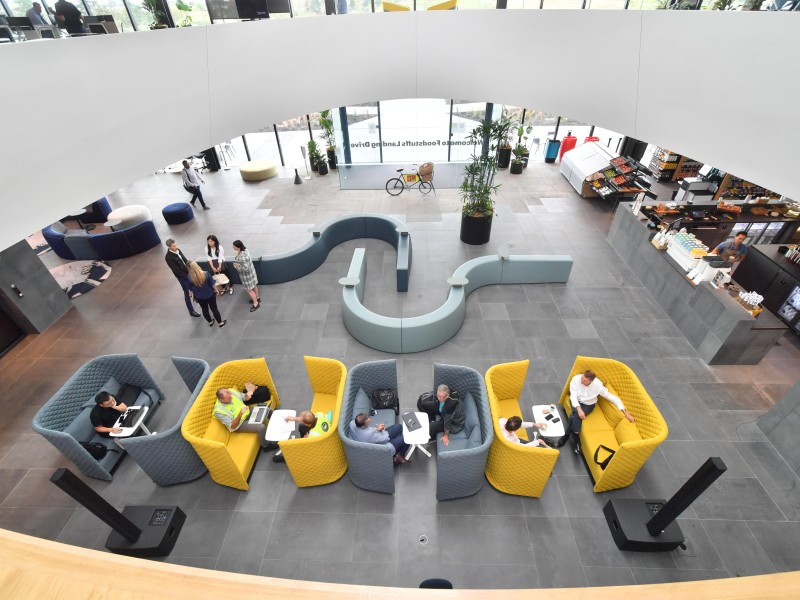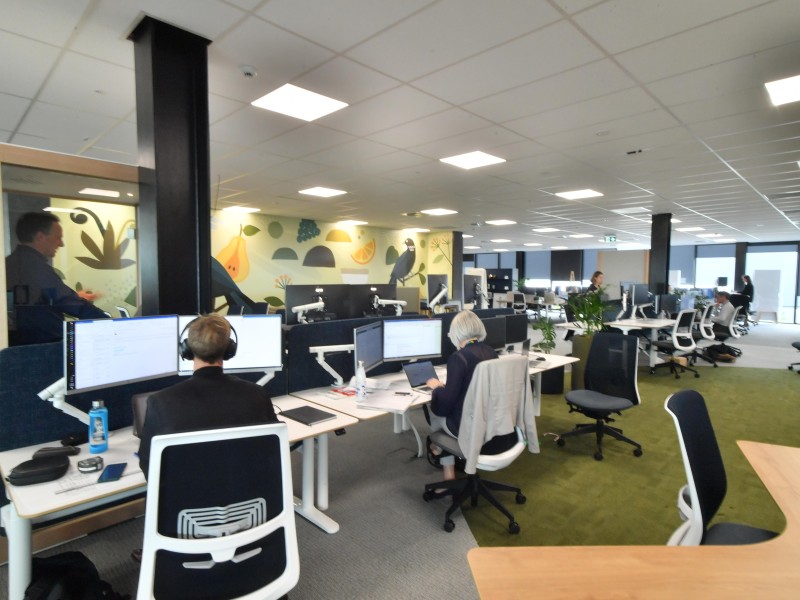Known as Foodstuffs Landing Drive, the striking 9000 square metre building is immersed in its local landscape - a more giant wedge of sculpture than a northern hub for New Zealand’s largest grocery co-operative.
While its wow factor form features an overarching curved roofline abutted with organic-shaped earth bunds, this building’s biggest wow is its ‘world leadership’ 6 Green Star rating.
Essentials
Name: Foodstuffs Landing Drive
What: Foodstuffs North Island Head Office
Where: The Landing – 100-hectare cutting-edge business park in Māngere developed and owned by Auckland International Airport Limited
Details: three-storey building comprising ground floor with entrance foyer, central atrium and specialist fit-out zones including a conference centre, training kitchen and in-house staff supermarket. The first and second floors are open-plan offices with flexible collaborative spaces
Occupancy capacity: 850 people
Site specifics: situated in an integrated campus, adjacent to a new 77,000 square metre Foodstuffs grocery distribution centre servicing 150 supermarkets/ grocery stores in the central and upper North Island
Address: 35 Landing Drive, Māngere, Auckland
Project Snapshot
Owner: Auckland International Airport Limited
Building Tenant: Foodstuffs North Island ( initial 30 year lease)
Architect: Monk Mackenzie
Main contractor: Hawkins
Project status: commenced October 2018, Construction commenced May 2019 completion December 2020, occupied March 2021
Project certification: 6 Green Star Built (v3) rating (February 2022). 5 Green Star Design rating (May 2020)

Foodstuffs Landing Drive's 6 Green Star rating is an accolade that demonstrates the sharp green-thinking partnership behind the project – its owner and developer Auckland International Airport Limited and tenant Foodstuffs North Island.
“From the get-go, this project was about creating a world-class and transformational environment for Foodstuffs North Island with sustainability, occupancy well-being and operational efficiency as our number one goal and we had a 5 Green Star target in place when Foodstuffs signed its initial lease,” Auckland Airport manager of project delivery, Peter Donovan says.
“That we’ve managed to achieve a 6 Green Stars speaks to the great collaboration and co-operation of a really unique partnership where both parties are determined to reduce their impact on the planet,” says Peter.
Foodstuffs North Island head of property investment, Nick Hanson, says investment in green-thinking is integrated into every square metre of the building.
“From the 3000 solar panels on our adjacent distribution centre supplying all head office energy needs to a rainwater harvesting system and planting of a tree for every chair we purchased for the building, sustainability has underpinned the entire building process,” Nick says.
“To be recognised with 6 Green Stars is a testament to the hard work our teams have put in and the great alliance we’ve had with Auckland Airport and our shared goal to lower our carbon footprint.”
Nick says while Foodstuffs Landing Drive is the company’s first Green Star rated building, moving forwards it’s looking at how other sites can be more sustainable.

Architect Sean Flanagan of Monk Mackenzie says the building acknowledges the natural heritage of its hinterland and Foodstuffs’ connections with whenua.
“Significant earthworks and geotechnical engineering were used to construct a landscape that is retained up and around the building so its main volume looks like it is embedded in the ground.”
He says the central image of the base-building appearing to emerge from the landscape forms an important conceptual link with Foodstuffs.
“Foodstuffs’ business model is a co-operative structure so it has important historical links to the nation’s producers, growers and people working the land,” he says.
Sean says Building Information Modelling (BIM) played a key role in honing the building’s green design.
“The BIM model helped inform design across solar performance, heating and cooling loads and volumes, envelope thermal efficiency, rainwater harvesting capacity, interior lighting levels for wellbeing, energy-saving and designing density of surrounding planting. It also enabled us to closely assess the impact of material and product selections.”
He says Monk Mackenzie wanted to design a building that was spatially engaging with key spaces to evoke a sense of wonder and engage the imagination, all finished with robust and durable materials.
“Hopefully this means the building contributes positively to Foodstuffs for a long time without the need for fundamental change and therefore without the need to consume further resources.”
Sean says we must acknowledge that all construction causes environmental harm.
“In the cold light of a climate emergency, Green Star measures harm mitigation. Our project team collectively tried to minimise the building’s impact on the planet and Green Star delivered an increased consciousness amongst us around the need to think and act differently,” says Sean.

That need to think and act differently in the green sphere has been a long-term focus for GSAP David Fullbrook, founder and senior consultant at eCubed, who has been promoting green design for 45 years.
“We’ve been involved with a number of 6 Green Star projects along the way and each one moves the dial a bit further as you’d expect.”
He says the Foodstuffs Landing Drive project is stand out for its renewable energy component, which is the largest rooftop PV array currently in New Zealand, delivering net-zero energy and carbon status to the head office building.
“The other stand-out aspect is the partnership between owner Auckland Airport and tenant Foodstuffs which facilitated a long-term lease enabling a much higher level of sustainability to be injected into the project. It was a case of ‘what can we do together to achieve a really great sustainable outcome for this building?’ So sustainability was baked in from the very start.”
David says other exemplary green elements of the build are:
- high-performance curtain wall systems balance heat gain, heat loss and natural light
- the central atrium promoting occupancy comfort with outside awareness and natural light
- high standards of building testing and commissioning and building tuning
- a long-term life cycle commitment by landlord and tenant
He says despite the major challenges posed by Covid-19, the Auckland Airport/Foodstuffs North Island partnership “encouraged us not to close the agenda down but expand it to 6 Green Stars at a late stage and in a very uncertain environment.”
Delivering that agenda was the main contractor Hawkins who had over 200 subcontractors and staff on-site during the peak of the Foodstuffs Landing Drive build.
Equipped with ISO14001 accreditation, Hawkins followed a site-specific Environmental Management Plan (EMP) for the project.
Hawkins project manager, Sam Gordon, says during the build, toolbox and coordination meetings were used to present specific detail around targeted Green Star points to raise awareness.
“With Green Star lots of important design decisions on things like material selections and building services systems are made up-front so we’ve got a responsibility to ensure the correct products are used on-site and accurate records are retained. We’re really keen for our subcontractors to fully understand Green Star requirements and the project provided a great opportunity to upskill our workers on sustainable principles.”
Even with the disruption of Covid-19, the project was delivered around four months ahead of schedule.
“This was a really enjoyable project to work on with a great team of subcontractors, consultants and our client. Hawkins has been very excited and proud of the 6 Green Star result and we realise the achievement and significance of completing a building with world leadership credentials,” Sam says.

The look and feel of those world leadership green credentials are being embraced by the building’s occupants on a daily basis.
“From the moment you drive around the corner to see the building rising from the ground with the sun reflecting off the glass, there’s a sense of calm and wellbeing. Everything is very earthy and simple with lots of natural light flooding in through the floor-to-ceiling windows and the atrium at the heart of the building. A lot of planting and stone bring the natural environment inside where the layout encourages you to move around and mix up your day in different work settings,” says Foodstuffs People & Capability team member, Michael Allen.
Foodstuffs technical facilities manager, Andrew Reynolds, believes the building demonstrates Foodstuffs is serious about protecting the planet.
“It gives my colleagues and me a sense that the company is making the right move to a more sustainable future, respecting Aotearoa’s natural resources and trying to limit its carbon emissions. Landing Drive is our kāinga and a place where we can appreciate thermal comfort and collaborate and enjoy – whilst knowing our workplace is giving back to the environment.
Andrew says the building’s greenness “creates a happier, healthier and agile sense of wellbeing. People are at the heart of this building, through functionality and design – that’s what a green building really is about – people.”
And Nick Hanson of Foodstuffs couldn’t agree more.
After all, it was a green-principled partnership of people who delivered the building’s six-star score.
“We’re just stoked to be a world leader in sustainability,” he says.
Green features include:
|
Technical features include:
|
